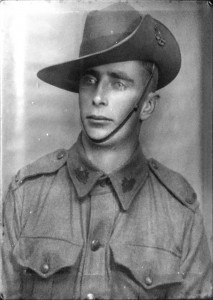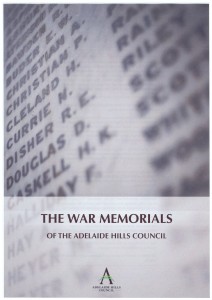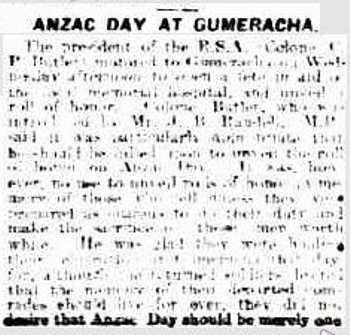Reminiscences of WW2 from My Grandparents – Part 1
“Don’t talk about the war to your grandparents”. That’s what I was told. So I didn’t.
But fortunately for me (and the rest of my family), someone did. And for that I’m eternally grateful.
When a friend was doing a school project on WW2 and needed to interview someone about the war, and didn’t have any reli’s here in Australia who were in the war, she asked my grandparents, Cecil and Evelyn Hannaford (nee Randell).
So I have to thank both Cathryn and my grandparents for this, because if she hadn’t asked, I guarantee that these memories would have been lost forever.
Before I begin I shall just say that the original interview is quite long, so I won’t include every question, but even so it’s still long enough that I’ll split this over two posts.
The introduction …
As a brief introduction, at age 25 Cecil Hannaford joined the army in 1940, and was trained at Woodside Army Camp before going aboard in 1941. During his time with the army he travelled to Libya, Palestine, Syria and Egypt. Aged 25 when he signed up, he went away as a driver, but also had to man the anti-aircraft guns at times.
My grandma, Evelyn Hannaford (nee Randell) lived at Gumeracha with her family during the war. On their farm they grew vegetables which were needed for the army.
The interview …
How old were you when World War II was declared?
Mrs H. 23 years old.
Mr H. 25 years old.
In what country were you living in? In what state?
Both. Australia, South Australia. Living at Cudlee Creek.
Were you living at Cudlee Creek all through the war?
Mrs H. I was at Gumeracha during the war.
Mr H. I was all over the place.
Do you remember what you were doing on the day it was declared?
Mrs H. No.
Mr H. Probably working.
Did someone tell you about it or did you hear it on the radio?
Both. Heard it on the radio.
Mr H. We were up are your (Mrs H.) place when we heard it.
Mrs H. Sir Winston Churchill announced it that England had declared war on Germany.
Mr H. Then Menzies, our Prime Minister followed.
So you knew each other then?
Mr H. Yes, we were going together (going out).
How did you feel when it was declared? Were you really bothered?
Mr H. No, not really.
Mrs H. Never too much notice because it was still overseas in those days, it only got much closer when Darwin was bombed.
How did your life change after the outbreak of the war? Did it change dramatically?
Mrs H. I think it might have changed in that were were soldiers about, has to really put our nose to the grindstone.
How did it affect your family?
Mrs H. The boys all had to go for medicals. What did they call that?
Mr H. Conscription. You were either conscripted or volunteered, whichever you preferred.
Mrs H. One brother, well I suppose they both volunteered, but one was rejected and one was kept. He went into the airforce.
Were you in the Army, or the navy or the airforce?
Mr H. In the army. About 1940 I joined. We stayed in South Australia for just after twelve months.
Were you trained at all?
Mr H. We were trained at Woodside Army Camp. Then we were married in 1941 and went away soon after that.
Where did you go to?
Mr H. We went to [unreadable], then on to Palestine for a little while, then went to Syria. Spent a few month in Syria, then down to Egypt, to El Alamein.
Did you have to wear a uniform?
Mr H. Oh yes. It was khaki green.
Was it horrible?
Mr H. No it wasn’t that bad.
Mrs H. They look very smart in their uniforms.
Mr H. We had a khaki woollen uniform and then we had the cotton uniform which was a paler shade for working.
What was the fighting like where you were?
Mr H. As far a I was concerned it wasn’t too bad, because we were on the big guns.
What was that like?
Mr H. Very nice!
Mrs H. Yes. He went away as a driver for most of the time, but when we had a fight on we had to help on the guns especially as they had one or two casualties.
What did you eat? Did you have ample food?
Mr H. Oh yes. Quite sufficient food. We had stews, sardines, tinned fish, salmon.
What was the stew like?
Mr H. It was as good as you could have expected from an army cook. It wasn’t too bad.
Do you think that all of that has changed you outlook of life?
Mr H. Very little. I don’t think I’ve changed much that way as far as that goes.
Did you do anything which was related to the war?
Mrs H. Yes. We grew the vegetables for the army.
What vegetables were they?
Mrs H. Oh everything. Carrots, turnips, swedes, beans, peas, caulis, cabbage, pumpkins, everything imaginable.
So they all went into the stew?
Mrs H. Yes. But I never cooked it, we only grew them.
Did you receive many letters from your family?
Mrs H. We didn’t get many letters between each of us. They all had to be censored before they went out and before they came home. One of my letter I got he (Mr H.) had said, take the stamp off and you will find our what boat I came on. And, of course that stamp has been taken off and the piece cut out of the envelope, we knew all the same that he got on the Queen Elizabeth.
Mr H. That was a good experience sailing on the Queen Elizabeth up to Palestine.
What was it like?
Mr H. Fantastic.
Was it a normal size boat or a big ship?
Mr H. it was very big. It was especially set up for troop carrying.
So there were lots and lots of soldiers on there?
Mr H. Yes. Thousands.
Mrs H. They had a terrific life! They had to take turns in going to bed.
Mr H. No. That was the Americans. The Americans were taken across to France and Britain and there they took it in turns sleeping in the beds. It’s one of those trips (on the QE) that you read about but never see because we were going around the South Coast on the Southern Ocean, before we went to Perth called into Fremantle and then we went onto Trincomalee. Going across the South Ocean was fairly rough and this old boat, just a gentle roll it was just marvellous to travel on.
Mrs H. There were so many on it, so it was stable. Nothing like going across to Tasmania on the little boat.
——————
The rest of the interview will follow in Part 2. In that they cover weather, ration books, working, war precautions at home, dropping of the bomb, end of war, coming home and more.
But one more mention need to be made to Cathryn for allowing me to reproduce some of her assignment (interview) here. THANKYOU .
“War Memorials of the Adelaide Hills” Book
The Adelaide Hills Council was fortunate to obtain a grant through the South Australian Government’s “Anzac Day Commemoration Fund“. For this they nominated that the funds would be used towards “research and preservation of Honour Board Memorials of Adelaide Hills”, and to “engage with schools and local groups to locate and research honour boards for inclusion in the publication War Memorials of the Adelaide Hills”.
To commemorate Anzac 2015, a publication “War Memorials of the Adelaide Hills” was produced which details information about the war memorials throughout the Adelaide Hills in the towns covered by the Council, giving town name with details of the monuments.
A second edition of “War Memorials of the Adelaide Hills”, that will also include additional material and corrections that have been made by the community will also be produced, and released in due course.
The Council also have a separate project to research, photograph and record details on all the honour boards in the Council area. While the majority of the honour boards can be found in local RSLs, community halls and schools, others have found their way to more obscure locations. The lack of detail of honour boards made it difficult to provide a comprehensive account of the memorials within the Council area. The aim is for this one to be released as a book as well.
The Adelaide Hills Council covers a large area in the Hills region, and includes the towns: Aldgate, Aldgate Valley, Ashton, Balhannah, Basket Range, Birdwood, Bradbury, Bridgewater, Carey Gully, Castambul, Chain of Ponds, Charleston, Cherryville, Crafers, Crafers West, Cudlee Creek, Dorset Vale, Eagle on the Hill, Forest Range, Forreston, Greenhill, Gumeracha, Heathfield, Houghton, Humbug Scrub, Inglewood, Inverbrackie, Ironbank, Kenton Valley, Kersbrook, Lenswood, Lobethal, Longwood, Lower Hermitage, Marble Hill, Millbrook, Montacute, Mount George, Mount Lofty, Mount Torrens, Mylor, Norton Summit, Oakbank, Paracombe, Piccadilly, Rostrevor, Scott Creek, Stirling, Summertown, Teringie, Upper Hermitage, Upper Sturt, Uraidla, Verdun, Woodforde, and Woodside.
Can you help?
The Adelaide Hills Council believe that honour boards are another link in conserving our heritage and in the recognition of the sacrifice made by young men and women at times of war, and they are after your help. If you know the whereabouts of any honour boards within the district please let them know.
Contact Details
project convenor: Helen Smith
phone: (08) 8408 0400
email: mail@ahc.sa.gov.au
web: www.ahc.sa.gov.au
World War One: “Out With the German Names”
There’s no doubt that almost every Australian family was affected by World War One in some way or another.
One sad fact that came out of World War One, was the intense hatred of Germans that emerged, together with all things German. The German families who emigrated to Australia and were happily living their lives, being a part of so many local communities. However when war broke out they were suddenly classed as an “enemy alien” purely because of their heritage, with many sent to concentration camps. Yes, even in South Australia.
South Australia had a substantial German population, so much so that many towns and other geographical localities had German names. However, come the start of World War One … and all things German was “the enemy”, so to have German place names was no longer acceptable. To rectify this a Bill was passed to change the name of numerous German named towns and localities towns in South Australia.
To make life easier for all I have compiled a listing of the places that were affected, together with their new name.
| German Place Names in South Australia | |
| Original name | Substitute name |
| Bartsch’s Creek | Yedlakoo Creek |
| Hundred of Basedow | Hundred of French |
| Cape Bauer | Cape Wondoma |
| Berlin Rock | Panpandie Hock |
| Bethanien | Bethany |
| Bismarck | Weeroopa |
| Blumberg | Birdwood |
| Blumenthal | Lakkari |
| Buchfelde | Loos |
| Carlsruhe (or Karlsruhe) | Kunden |
| Ehrenbreistein | Mount Yerila |
| Ferdinand Creek | Ernaballa Creek |
| Mount Ferdinand | Mount Warrabillinna |
| Friedrichstadt | Tangari |
| Friedrichswalde | Tarnma |
| Gebhardt’s Hills | Polygon Ridge |
| German Creek | Benara Creek |
| German Pass | Tappa Pass |
| Germantown Hill | Vimy Ridge |
| Gnadenfrei | Marananga |
| Gottlieb’s Well | Parnggi Well |
| Grunberg (or Gruenberg) | Karalta |
| Grunthal | Verdun |
| Hahndorf | Ambleside |
| Hasse’s Mound | Larelar Mound |
| Heidelberg | Kobandilla |
| Hergott Springs | Marree |
| Hermann’s Landing | Moramora (& later Nildotti) |
| Hildesheim | Punthari |
| Hoffnungsthal | Karawirra |
| Hundred of Homburg | Hundred of Haig |
| Jaenschtown | Kerkanya |
| Kaiserstuhl | Mount Kitchener |
| Klaebes | Kilto |
| Klemzig | Gaza |
| Krause Rock | Marti Rock |
| Hundred of Krichauff | Hundred of Beatty |
| Krichauff | Beatty |
| Kronsdorf | Kabminye |
| Langdorf | Kaldukee |
| Langmeil | Bilyara |
| Lobethal | Tweedvale |
| Mount Meyer | Mount Kauto |
| Muller Hill | Yandina Hill |
| Neudorf | Mamburdi |
| Neukirch | Dimchurch |
| New Hamburg | Willyaroo |
| New Mecklenburg | Gomersal |
| Oliventhal | Olivedale |
| Hundred of Paech | Hundred of Cannawigra |
| Petersburg | Peterborough |
| Hundred of Pflaum | Hundred of Geegeela |
| Rhine Flat Landing | Wongulla |
| Rhine Hill | Mons |
| Rhine Park | Parklo (& later Kongolia) |
| Rhine River North | The Somme |
| Rhine River South | The Marne |
| Rhine Villa | Cambrai |
| Hundred of Rhine North | Hundred of Jellicoe |
| Hundred of Rhine South | Hundred of Jutland |
| Rosenthal | Rosedale |
| Hundred of Scherk | Hundred of Sturdee |
| Schoenthal | Boongala |
| Hundred of Schomburgk | Hundred of Maude |
| Seppelts | Dorrien |
| Schreiberhau | Warre |
| Siegersdorf | Bultawilta |
| Steinfeld | Stonefield |
| Summerfeldt | Summerfield |
| Vogelsang’s Corner | Teerkoore |
| Hundred of Von Doussa | Hundred of Allenby |
| Wusser Knob (or Wusser Nob) | Karun Knob |
Some of these places have since reverted back to their original German name, while others didn’t.
Trove has many articles that relate to the changing (or not changing, or changing back) of the German place names. Here’s links to just found of them I found interesting:
http://nla.gov.au/nla.news-article53438060
http://nla.gov.au/nla.news-article46843946
http://nla.gov.au/nla.news-article60609846
http://nla.gov.au/nla.news-article60331944
Anzac Day at Gumeracha
The town of Gumeracha in South Australia is a small town. It’s the kind of country town, where everyone knows everyone, and everything. The kind of town you walk down the street and say hello to everyone on the way. Putting it simply, it’s a quiet, friendly town.
With a population of only a few hundred in the early 1900s, you can imagine that when the call came in 1914 for men to ‘serve their country’, and the locals joined up, it wasn’t just families affected, but rather the whole town would have felt it … in numerous ways.
For my Anzac Day post this year, I decided to head to Trove, to see what the newspapers had to say about Anzac Day at Gumeracha.
I fully expected to read about commemoration services, and town gatherings and so on, kind along the lines of what the town does nowadays. But what I didn’t expect to find was that they held Fairs or Fetes on Anzac Day. Yes, true. Trove surprises me yet again! But it makes sense when you realise that the town wanted to build a hospital as a permanent memorial to the locals who fought and paid the ultimate price in the First World War, so fundraising was needed.
In 1921 the Gumeracha Fair had stallholders, competitions and a concert …
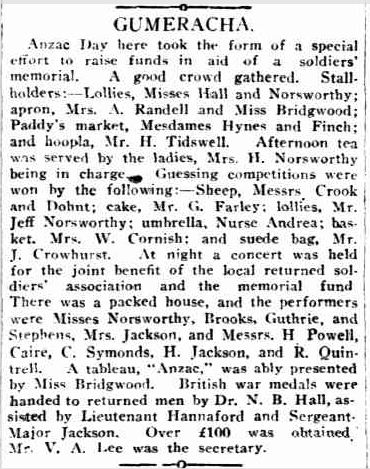
GUMERACHA, The Mount Barker Courier and Onkaparinga and Gumeracha Advertiser,6 May 1921, p. 3.
http://nla.gov.au/nla.news-article146431159
In 1922 the Fair was a “Japanese” theme, complete with a decorated umbrella parade … as this is a long article, I’ve only included a portion of it below. But you can view the full entry on Trove here.
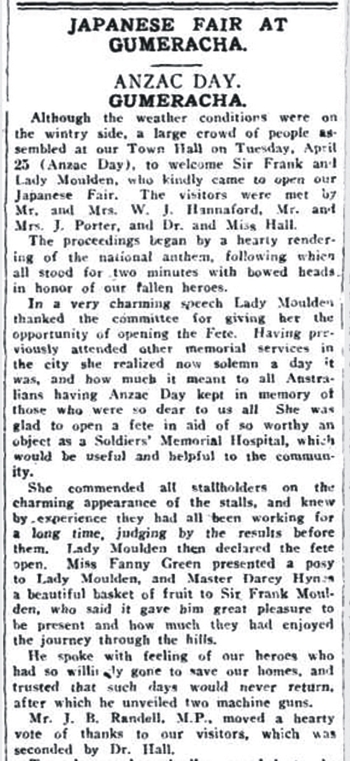
JAPANESE FAIR AT GUMERACHA. The Mount Barker Courier and Onkaparinga and Gumeracha Advertiser, 5 May 1922, p. 2.
http://nla.gov.au/nla.news-article147755089
In 1923 I found two references to Anzac Day in the newspapers. On the 16th of April 1923, The Advertiser has a brief report of the more formal and solemn part of the day. Unfortunately the printing in the newspaper is really bad as you’ll see from below, so I’ve included the transcription as well …

ANZAC DAY AT GUMERACHA. The Advertiser, 26 April 1923, p. 11.
http://nla.gov.au/nla.news-article37307949
ANZAC DAY AT GUMERACHA.
The president of the R.S.A. Colonel C. P. Butler motored to Gumeracha on Wednesday afternoon to open a fete in aid of the local memorial hospital and unveil a roll of honor. Colonel Butler. who [?] [?] by Mr J. B. Randell, M.P. said it was particularly appropriate that he should be called upon to unveil the roll of honor on Anzac Day. It was how ever [?] to unveil roll of honor in memory of those who fell [?] they were[?] prepared at citizens to do their duty and make the sacrifice of those men worthwhile. He was glad they were [?] [?] at Gumeracha t[?] day for although the returned soldiers [?] that the memory of their departed comrades should live for ever, they did not desire that Anzac Day should be merely one of mourning. It should be a day of rejoicing as well as of remembrance, and of pride in the deeds of their gallant dead.
While on the 28th of April 1923, The Register goes into detail about the Fair, the stallholders, the concert and football match …
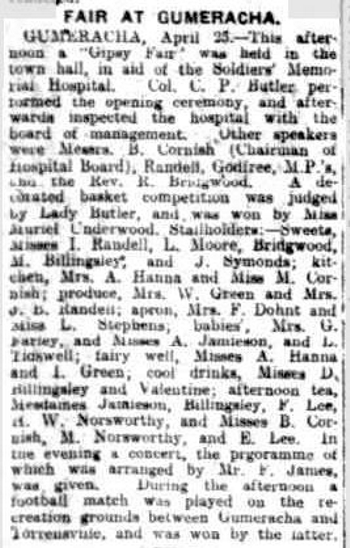
FAIR AT GUMERACHA. The Register, 28 April 1923, p. 14.
http://nla.gov.au/nla.news-article64182616
Through the efforts of the fundraising committee, together with regular working bees, the Gumeracha Soldiers Memorial Hospital was built and was officially opened in 22 July 1922.
In the “Gumeracha District Soldiers Memorial Hospital Diamond Jubilee 1922-1982” book it quotes the following … “one of the first things you see as you enter the door is the Honour Roll for World War I, 1914-18” along with the names as below:
Lieut. T.M. Pflaum
Corp. W.H. Green
Pte. C.C. Ahrens
Pte. L.G. Bennett
Pte. R. Blain
Pte. J. Bronha
Pte. W. Burton
Pte. T.F. Constable
Pte. W.J. Coombe
Pte. G.M. Crook
Pte. B.C. Crouch
Pte. V.P. Crowhurst
Pte. L.W. Fitzsimons
Pte. T.J. Hicks
Pte. W.J. Hodgson
Pte. E. Jeffery
Pte. M. McGough
Pte. J.A. Menz
Pte. R.R. Palmer
Pte. T.G.W. Palmer
Pte. R.H. Pflaum
Pte. V.L. Robinson
Pte. R. Turner
Pte. W.R. Wood
This hopsital still stands today, and looks largely the same as the photo above. It is a testament to the people of Gumeracha that this beautiful memorial was built, and still serves the community today.
I would have liked to have finished this post with a photo of the actual Honour Roll that’s in the hospital, however as I don’t have one as yet (it is on my list of things I must photograph), so instead I shall share the photo of the “Official Part at the Gumeracha District Soliders Memorial Hospital opening in July 1922”.
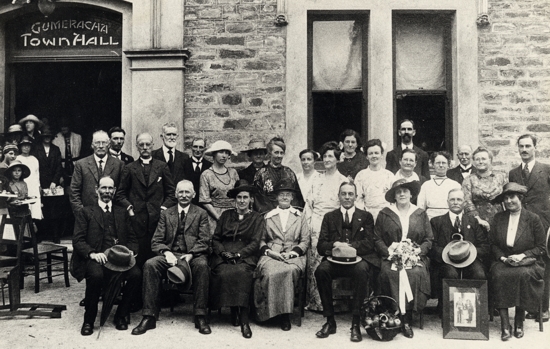
Official Party at the Gumeracha District Soldiers Memorial Hospital opening, July 1922
Standing L-R: S. Kitto, V. Lee, Rev. Bridgwood, Ben Cornish, Elliott Hannaford, Lyn Dohnt, Mrs W.H. Cornish, Mrs J. Hynes, Mrs T. Tidswell, Mrs Schrader, Mrs Lemmey, Miss Elsa Bridgwood, J.B. Randell, Mrs Ted Clarke, Mrs Rob Moore, Mrs Wood, Mrs Finch, Dr Hall
Sitting L-R: Jasper Porter, Jack Hynes, Mrs W.J. Hannaford, Mrs J. Porter, Sir Arnold Moulden, Lady Moulden, W.J. Hannaford, Miss Hall

